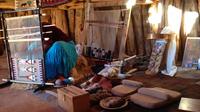Cultural Tour of Lower Monument Valley Tribal Park
Oljato-Monument Valley, Utah
Rating: 









Trip Type: Cultural Tours
Duration: 3 hours 30 minutes
The Cultural Tour is a 3.5 hour tour in the Backcountry of the Lower Monument Valley Tribal Park. The tour focuses on the Navajo culture by visiting a local Hogan Demonstration, hearing the stories our guides have to share and musical entertainment.
More About This Activity All Cultural Tours →
The Cultural Tour is a 3.5 hour tour in the Backcountry of the Lower Monument Valley Tribal Park. The tour focuses on the Navajo culture by visiting a local Hogan Demonstration, hearing the stories our guides have to share and musical entertainment.
The Navajo culture has thrived on the land between the Four Scared Mountains, and those teachings have been inherited through generations of verbal and lesson teaching methods. Some of these teachings are shared with you during the Cultural Tour by your Navajo guide.
The Cultural, 3.5 hour tour makes a first stop at the famous John Ford’s Point where many of John Wayne’s western cinematic movies were filmed. Next, your guide will drive to The Backcountry of the park and escort you to the “Sun’s Eye Arch" and Hogan Demonstration.
At “Sun’s Eye Arch” you will be standing at a specific degree to look up into the rock arch and see why it is named Sun’s Eye. At the same location you will also see Petroglyphs and hear your guide’s stories.
Next, you will travel to the “Big Hogan.” The Big Hogan is a great place to take family pictures and lie against the rocks and feel its warmth. Your guide will provide stories and suggest great photo shots.
The last stop in the Backcountry is the “Ear of the Wind.” This is the largest arch in the park, and your guide will escort you to a photogenic spot where you can take photographs.
Next, you will be guided to the Totem Pole and Yei Bi Cheii Monuments where you will be able to take photographs and hear the cultural stories behind each monument. The last stop is at the North Window where you will have a chance to take pictures of the Mittens and Butte at a different angle. Your tour guide will then slowly and safely transport you back to your departure point.
Unfortunately, we cannot give much information about our guides’ stories because each guide has very uniquely different stories to tell. Our guides’ stories come from personal experience, lore, legends and the Navajo culture.
The Navajo culture has thrived on the land between the Four Scared Mountains, and those teachings have been inherited through generations of verbal and lesson teaching methods. Some of these teachings are shared with you during the Cultural Tour by your Navajo guide.
The Cultural, 3.5 hour tour makes a first stop at the famous John Ford’s Point where many of John Wayne’s western cinematic movies were filmed. Next, your guide will drive to The Backcountry of the park and escort you to the “Sun’s Eye Arch" and Hogan Demonstration.
At “Sun’s Eye Arch” you will be standing at a specific degree to look up into the rock arch and see why it is named Sun’s Eye. At the same location you will also see Petroglyphs and hear your guide’s stories.
Next, you will travel to the “Big Hogan.” The Big Hogan is a great place to take family pictures and lie against the rocks and feel its warmth. Your guide will provide stories and suggest great photo shots.
The last stop in the Backcountry is the “Ear of the Wind.” This is the largest arch in the park, and your guide will escort you to a photogenic spot where you can take photographs.
Next, you will be guided to the Totem Pole and Yei Bi Cheii Monuments where you will be able to take photographs and hear the cultural stories behind each monument. The last stop is at the North Window where you will have a chance to take pictures of the Mittens and Butte at a different angle. Your tour guide will then slowly and safely transport you back to your departure point.
Unfortunately, we cannot give much information about our guides’ stories because each guide has very uniquely different stories to tell. Our guides’ stories come from personal experience, lore, legends and the Navajo culture.
« Go Back

